Application of Super Absorbent Polymer and Plant Mucilage Improved Essential Oil Quantity and Quality of Ocimum basilicum var. Keshkeni Luvelou
Abstract
1. Introduction
2. Results and Discussion
2.1. Total Dry Matter (Biomass)
2.2. Water Use Efficiency (WUE)
2.3. Leaf Area
2.4. Essential Oil Content (%v/w)
2.5. Essential Oil Yield
2.6. Essential Oil Quality
3. Materials and Methods
3.1. Experimental Design
3.2. Experimental Procedure
3.3. Dry Matter and Leaf Area
3.4. Water Use Efficiency
3.5. Essential Oil Extraction
3.6. Identification of Essential Oil Constituents
4. Conclusions
Supplementary Materials
Author Contributions
Funding
Conflicts of Interest
References
- Lange, D. Medicinal and aromatic plants: Trade, production, and management of botanical resources. In XXVI International Horticultural Congress: The Future for Medicinal and Aromatic Plants; ISHS: Leuven, Belgium, 2002; Volume 629, pp. 177–197. [Google Scholar] [CrossRef]
- Khalid, K.A. Influence of water stress on growth, essential oils, and chemical composition of herbs (Ocimum sp.). Int. Agrophys. 2006, 20, 289–296. [Google Scholar]
- Baczek, K.; Kosakowska, O.; Gniewosz, M.; Gientka, I.; We˛glarz, Z. Sweet Basil (Ocimum basilicum L.) Productivity and Raw Material Quality from Organic Cultivation. Agronomy 2019, 9, 279. [Google Scholar] [CrossRef]
- Viyoch, J.; Pisutthanan, N.; Faikreua, A.; Nupangta, K.; Wangtorpol, K.; Ngokkuen, J. Evaluation of in vitro antimicrobial activity of Thai basil oils and their micro-emulsion formulas against Propionibacterium acnes. Inte. J. Cosmet. Sci. 2006, 28, 125–133. [Google Scholar] [CrossRef] [PubMed]
- Arranz, E.; Jaime, L.; de las Hazas, M.L.; Reglero, G.; Santoyo, S. Supercritical fluid extraction as an. alternative process to obtain essential oils with anti-inflammatory properties from marjoram and sweet basil. Ind. Crops Prod. 2015, 67, 121–129. [Google Scholar] [CrossRef]
- Kalamartzis, I.; Dordas, C.; Georgiou, P.; Menexes, G. The Use of Appropriate Cultivar of Basil (Ocimum basilicum) Can Increase Water Use Efficiency under Water Stress. Agronomy 2020, 10, 70. [Google Scholar] [CrossRef]
- Lal, R.K.; Khanuja, S.P.S.; Agnihotri, A.K.; Misra, H.O.; Shasany, A.K.; Naqvi, A.A.; Dhawan, O.P.; Kalra, A.; Bahl, J.R.; Darokar, M.P. High yielding eugenolrich oil producing variety of Ocimum sanctum—‘CIM-Ayu’. J. Med. Aromat. Plant. Sci. 2003, 25, 746–747. [Google Scholar]
- Lal, R.K.; Khanuja, S.P.S.; Agnihotri, A.K.; Shasany, A.K.; Naqvi, A.A.; Dwivedi, S.; Misra, H.O.; Dhawan, O.P.; Kalara, A.; Singh, A.; et al. An early, short duration, high essential oil, methyl chavicol, and linalool yielding variety of Indian Basil(Ocimum basilcum) ‘CIM- Saumya’. J. Med. Aromat. Plant. Sci. 2004, 26, 77–78. [Google Scholar]
- Lal, R.K.; Khanuja, S.P.S.; Rizavi, H.; Shasany, A.K.; Ahmad, R.; Chandra, R.; Naqvi, A.A.; Misra, H.O.; Singh, A.; Singh, N.; et al. Registration of a high yielding dark purple pigmented, variety ‘CIM-Angana’ of Shyam tulsi (Ocimum sanctum L.). J. Med. Aromat. Plant. Sci. 2008, 30, 92–94. [Google Scholar]
- Bekhradi, F.; Luna, M.C.; Delshad, M.; Jordan, M.J.; Sotomayor, J.A.; Martínez-Conesa, C.; Gil, M.I. Effect of deficit irrigation on the postharvest quality of different genotypes of basil including purple and green Iranian cultivars and a Genovese variety. Postharvest Biol. Technol. 2015, 100, 127–135. [Google Scholar] [CrossRef]
- Ekren, S.; Sönmez, Ç.; Özçakal, E.; Kurttaş, Y.S.K.; Bayram, E.; Gürgülü, H. The effect of different irrigation water levels on yield and quality characteristics of purple basil (Ocimum basilicum L.). Agric. Water Manag. 2012, 109, 155–161. [Google Scholar] [CrossRef]
- Marvat, S.K.; Rehman, F.U.; Khan, M.S.; Ghulam, S.; Anwar, N.; Mustafa, G.; Usman, K.H. Phytochemical constituents and pharmacological activities of sweet basil-Ocimum basilicum L. (Lamiaceae). Asian J. Chem. 2011, 23, 3773–3782. [Google Scholar]
- Tangpao, T.; Chung, H.H.; Sommano, S.R. Aromatic profiles of essential oils from five commonly used Thai basils. Foods 2018, 7, 175. [Google Scholar] [CrossRef] [PubMed]
- Bobakulov, K.; Ozek, G.; Ozek, T.; Asilbekova, D.T.; Abdullaev, N.D.; Sagdullaev, S.S.; Başer, K.H.C. Essential oils and lipids from the flowers of two varieties of Ocimum basilicum L. cultivated in Uzbekistan. J. Essent. Oil Res. 2020, 2020, 1–8. [Google Scholar] [CrossRef]
- Muráriková, A.; Ťažký, A.; Neugebauerová, J.; Planková, A.; Jampílek, J.; Mučaji, P.; Mikuš, P. Characterization of Essential Oil Composition in Different Basil Species and Pot Cultures by a GC-MS Method. Molecules 2017, 22, 1221. [Google Scholar] [CrossRef]
- Zahedi, H.; Noormohammadi, G.; Shirani- Rad, A.H.; Habibi, D.; Akbar-BoojarMashhadi, M. The effects of Zeolite and foliar applications of selenium on growth, yield and yield components of three canola cultivars under drought stress. J. World Appli. Sci. 2009, 7, 255–262. [Google Scholar] [CrossRef][Green Version]
- Andry, A.; Yamamoto, T.; Irie, T.; Moritani, S.; Inoue, M.; Fujiyama, H. Water retention, hydraulic conductivity of hydrophilic polymers in sandy soil as affected temperature and water quality. J. Hydr. 2009, 373, 177–183. [Google Scholar] [CrossRef]
- Shankarappa, S.K.; Muniyandi, S.J.; Chandrashekar, A.B.; Singh, A.K.; Nagabhushanaradhya, P.; Shivashankar, B.; Elansary, H.O. Standardizing the Hydrogel Application Rates and Foliar Nutrition for Enhancing Yield of Lentil (Lens culinaris). Processes 2020, 8, 420. [Google Scholar] [CrossRef]
- Behera, S.; Mahanwar, P.A. Superabsorbent polymers in agriculture and other applications: A review. Polym. Plast. Technol. Mater. 2020, 59, 341–356. [Google Scholar] [CrossRef]
- Francesco, F.; Montesano, A.; Angelo Parente, A.; Pietro Santamaria, B.; Alessandro Sannino, C.; Francesco Serio, A. Biodegradable superabsorbent hydrogel increases water retention properties of growing media and plant growth. Agric. Agric. Sci. Procedia 2015, 4, 451–458. [Google Scholar]
- Taban, M.; Movahedi-Naeini, S.A.R. Effect of aquasorb and organic compost amendments on soil water retention and evaporation with different evaporation potentials and soil textures. Commun. Soil Sci. Plant. Anal. 2006, 37, 2031–2055. [Google Scholar] [CrossRef]
- Huttermann, A.; Zommorodi, M.; Reise, K. Addition of hydrogels to soil for prolonging the survival of Pinus halepensis seedlings subjected to drought. J. Soil Till Res. 1999, 50, 295–304. [Google Scholar] [CrossRef]
- Nazarli, H.; Zardashti, M.R.; Darvishzadeh, R.; Najafi, S. The effect of water stress and polymer on water use efficiency, yield and several morphological traits of sunflower. J. Not. Sci. Biol. 2010, 2, 53–58. [Google Scholar]
- Yazdani, F.; Allahdadi, I.; Akbari, G.A. Impact of superabsorbent polymer on yield and growth analysis of soybean (Glycine max L.) under drought stress condition. Pak. J. Biol. Sci. 2007, 10, 4190–4196. [Google Scholar]
- Tongo, A.; Mahdavi, A.; Sayad, E. Effect of superabsorbent polymer aquasorb on chlorophyll, antioxidant enzymes and some growth characteristics of Acacia victoriae seedlings under drought stress. ECOPERSIA 2014, 2, 571–583. [Google Scholar]
- Ekebafe, L.O.; Ogbeifun, D.E.; Okieimen, F.E. Polymer applications in agriculture. Niger. Soc. Exp. 2011, 23, 81–89. [Google Scholar]
- Linberg, B.; Moshihuzzaman, M.; Nahar, N.; Abeysekera, R.M.; Borwn, R.G.; Willison, J.H.M. An unusual (4-0-methyl –d-glucurono) –d-xylan isolated from the mucilage of seeds of the quince tree (Cydonia oblonga L.). Carbohydr. Res. 1990, 207, 307–310. [Google Scholar] [CrossRef]
- Carminati, A.; Moradi, A. How the soil-root interface affects water availability to plants. Geogr Res. Abstr. 2010, 12, 10677. [Google Scholar]
- Agaba, H.; Orikiriza, L.J.B.; Obua, J.; Kabasa, J.D.; Worbes, M.; Hüttermann, A. Hydrogel amendment to sandy soil reduces irrigation frequency and improves the biomass of Agrostis stolonifera. Agric. Sci. 2011, 2, 544–550. [Google Scholar] [CrossRef]
- Pirzad, A.; Fayyaz-Moghaddam, A.; Razban, M.; Raei, Y. He evaluation of dried flower and essential oil yield and harvest index of Matricaria chamomilla L. under varying irrigation regimes and amounts of super absorbent polymer (A200). Iran. J. Agric. Sci. 2012, 22, 85–99. [Google Scholar]
- Masud, Z.A.; Khotib, M.; Farid, M.; Nur, A.; Amroni, M. Superabsorbent derived from cassava waste pulp. Int. J. Recycl. Org. Waste Agric. 2013, 2, 8. [Google Scholar] [CrossRef]
- Tohidi-Moghadam, H.R.; Zahedi, H.; Ghooshchi, F. Oil quality of canola cultivars in response to water stress and superabsorbent polymer application. Pesqui. Agropecuária Trop. 2011, 41, 579–586. [Google Scholar]
- Roy, T.; Kumar, S.; Chand, L.; Kadam, D.M.; Bihari, B.; Shrimali, S.S.; Singh, L. Impact of Pusa hydrogel application on yield and productivity of rainfed wheat in North West Himalayan region. Curr. Sci. 2019, 116, 1246–1251. [Google Scholar] [CrossRef]
- Neethu, T.M.; Dubey, P.K.; Kaswala, A.R. Prospects and Applications of Hydrogel Technology in Agriculture. Int. J. Curr. Microbiol. App. Sci. 2018, 7, 3155–3162. [Google Scholar] [CrossRef]
- Saini, A.K.; Patel, A.M.; Chaudhary, P.P.; Saini, L.H. Impact assessment of irrigation, fertility and hydrogel levels on growth attributes, yield and economics of summer pearl millet (Pennisetum glaucum L.) under North Gujarat conditions. J. Pharm. Phytochem. 2018, 7, 2914–2918. [Google Scholar]
- Langaroodi, N.B.S.; Ashouri, M.; Dorodian, H.R.; Azarpour, E. Study effects of super absorbent application, saline water and irrigation management on yield and yield components of peanut (Arachis hypogaea L.). Ann. Biol. Res. 2013, 4, 160–169. [Google Scholar]
- Borivoj, S.; Rak, L.; Bubenikova, I. The effect of hydroabsorbent on selected soil biological and biochemical characteristics and its possible use in revitalization. Ecologia 2006, 25, 422–429. [Google Scholar]
- El-Hady, O.A.; Tayel, M.Y.; Lotfy, A.A. Super Gel as a soil conditioner II-Its effect on plant growth, enzymes activity, water use efficiency and nutrient uptake. In III International Symposium on Water Supply and Irrigation in the Open and under Protected Cultivation 119; ISHS Acta Horticulturae: Wageningen, The Netherlands, 1981; pp. 257–266. [Google Scholar]
- Landis, T.D.; Haase, D.L. Applications of hydrogels in the nursery and during outplanting. In National Proceedings: Forest and Conservation Nursery Associations-2011; Proc. RMRS-P-68; USDA Forest Service, Rocky Mountain Research Station: Fort Collins, CO, USA, 2012; pp. 53–58. [Google Scholar]
- Nirmala, A.; Guvvali, T. Hydrogel/superabsorbent polymer for water and nutrient management in horticultural crops. IJCS 2019, 7, 787–795. [Google Scholar]
- Pattanaaik, S.K.; Singh, B.; Wangchu, L.; Debnath, P.; Hazarika, B.N.; Pandey, A.K. Effect of hydrogel on water and nutrient management of Citrus limon. Int. J. Agric. Innov. Res. 2015, 3, 1656–1659. [Google Scholar]
- Banko, T.J. Medium amendment plus watering system may improve rooting [Terra-sorb, moisture retaining propagation mediums, tested on holly, juniper and azalea cuttings]. Am. Nurserym. 1984, 159, 51–53. [Google Scholar]
- Lichtfouse, E. Climate Change, Intercropping, Pest Control and Beneficial Microorganisms; Springer: Dordrecht, The Netherlands; Heidelberg, Germany; New York, NY, USA, 2009; pp. 229–232. [Google Scholar]
- SCF, European Commission. Opinion of the Scientific Committee on Food on Methyleugenol (4-allyl-1, 2-dimethoxybenzene). In Health and Consumer Protection Directorate-General; European Commission: Brussels, Belgium, 2001. [Google Scholar]
- Hussain, A.I.; Anwar, F.; Sherazi, S.T.; Przybylski, R. Chemical composition, antioxidant and antimicrobial activities of basil (Ocimum basilicum L.) Essential oils depends on seasonal variations. Food Chem. 2008, 108, 986–995. [Google Scholar] [CrossRef] [PubMed]
- Rahmati, M.; Vercambre, G.; Davarynejad, G.; Bannayan, M.; Azizi, M.; Génard, M. Water scarcity conditions affect peach fruit size and polyphenol contents more severely than other fruit quality traits. J. Sci. Food Agric. 2015, 95, 1055–1065. [Google Scholar] [CrossRef] [PubMed]
- Shahhoseini, R.; Saeidi, K.; Babaahmadi, H.; Ebadi, M.T. Effect of fertilizers and superabsorbent hydrogel on the yield, essential oil content and composition of Lemon verbena (Lippia citriodora Kunth.) cultivated in Iran. J. Essent. Oil Bear. Plants 2018, 21, 230–236. [Google Scholar] [CrossRef]
- Zheljazkov, V.D.; Callahan, A.; Cantrell, C.L. Yield and oil composition of 38 basil (Ocimum basilicum L.) accessions grown in Mississippi. J. Agric. Food Chem. 2008, 56, 241–245. [Google Scholar] [CrossRef]
- Ichimura, M.; Ikushima, M.; Miyazaki, T.; Kimura, M. Effect of phosphorus on growth and concentration of mineral elements and essential oils of sweet basil leaves. Hydroponics Transpl. Prod. 1994, 396, 195–202. [Google Scholar] [CrossRef]
- Shi, Y.; Li, J.; Shao, J.; Deng, S.; Wang, R.; Li, N.; Zheng, X. Effects of Stockosorb and Luquasorb polymers on salt and drought tolerance of Populus popularis. Sci. Hortic. 2010, 124, 268–273. [Google Scholar] [CrossRef]
- Timmermann, B.N.; Steelink, C.; Loewus, F.A. Phytochemical Adaptations to Stress: 18; Kluwer Academic/Plenum Publishers: Arizona, AZ, USA, 1984. [Google Scholar]
- Bettaieb, I.; Zakhama, N.; Aidi-Wannes, W.; Kchouk, M.E.; Marzouk, B. Water deficit effects on Salvia officinalis fatty acids and essential oils composition. Sci. Hortic- Amesterdam. 2009, 120, 271–275. [Google Scholar] [CrossRef]
- Klimankova, E.; Holadova, K.; Hajslova, J.; Cajka, T.; Poustka, J.; Koudela, M. Aroma profiles of five basil (Ocimum basilicum L.) cultivars grown under conventional and organic conditions. Food Chem. 2008, 107, 464–472. [Google Scholar] [CrossRef]
- Pengelly, A. The Constituents of Medicinal Plants an Introduction to the Chemistry and Therapeutics of Herbal Medicine, 2nd ed.; CABI Publishing: Wallingford, UK, 2004. [Google Scholar]
- Lee, S.J.; Umano, K.; Shibamoto, T.; Lee, K.G. Identification of volatile components in basil (Ocimum basilicum L.) and thyme leaves (Thymus vulgaris L.) and their antioxidant properties. Food Chem. 2005, 91, 131–137. [Google Scholar] [CrossRef]
- Kartnig, T.; Simon, B. Gehalt und zusammensetzung des ätherischen Öles verschiedener Sorten von Ocimum basilicum L. In Abhängigkeit Vom Erntezeitpunkt; Bayerischer Landwirschaftsverlag GmbH: München, Germany, 1986; pp. 223–225. [Google Scholar]
- Simon, J.E.; Reiss-Bubenheim, D.; Joly, R.J.; Charles, D.J. Water stress-induced alterations in essential oil content and composition of sweet basil. J. Essent. Oil Res. 1992, 4, 71–75. [Google Scholar] [CrossRef]
- Gupta, S.K.; Srivastava, S.; Trivedi, D.; Joshi, S.; Halder, N. Ocimum sanctum modulates selenite-induced cataractogenic changes and prevents rat lens opacification. Curr. Eye Res. 2005, 30, 583–591. [Google Scholar] [CrossRef]
- Chapman, H.D.; Pratt, P.F. Methods of Analysis for Soils, Plants and Water; Chapman Publishers: Riverside, CA, USA, 1982. [Google Scholar]
- Marlett, J.A.; Fischer, M.H. Unfermented gel fraction from psyllium seed husks. U.S. Patent 6,676,979, 13 January 2004. [Google Scholar]
- Payero, J.O.; Tarkalson, D.D.; Irmak, S.; Davison, D.; Petersen, J.L. Effect of timing of a deficit-irrigation allocation on corn evapotranspiration, yield, water use efficiency and dry mass. J. Agric. Water Manag. 2009, 96, 1387–1397. [Google Scholar] [CrossRef]
- Chizzola, R.; Saeidnejad, A.H.; Azizi, M.; Oroojalian, F.; Mardani, H. Bunium persicum: Variability in essential oil and antioxidants activity of fruits from different Iranian wild populations. Genet. Resour. Crop. Evol. 2014, 61, 1621–1631. [Google Scholar] [CrossRef]
- Amirmohammadi, F.Z.; Azizi, M.; Nemati, S.H.; Iriti, M.; Vitalini, S. Analysis of the essential oil composition of three cultivated Nepeta species from Iran. Zeitschrift für Naturforschung C 2020. [Google Scholar] [CrossRef] [PubMed]
Sample Availability: Samples of the compounds are not available from the authors. |
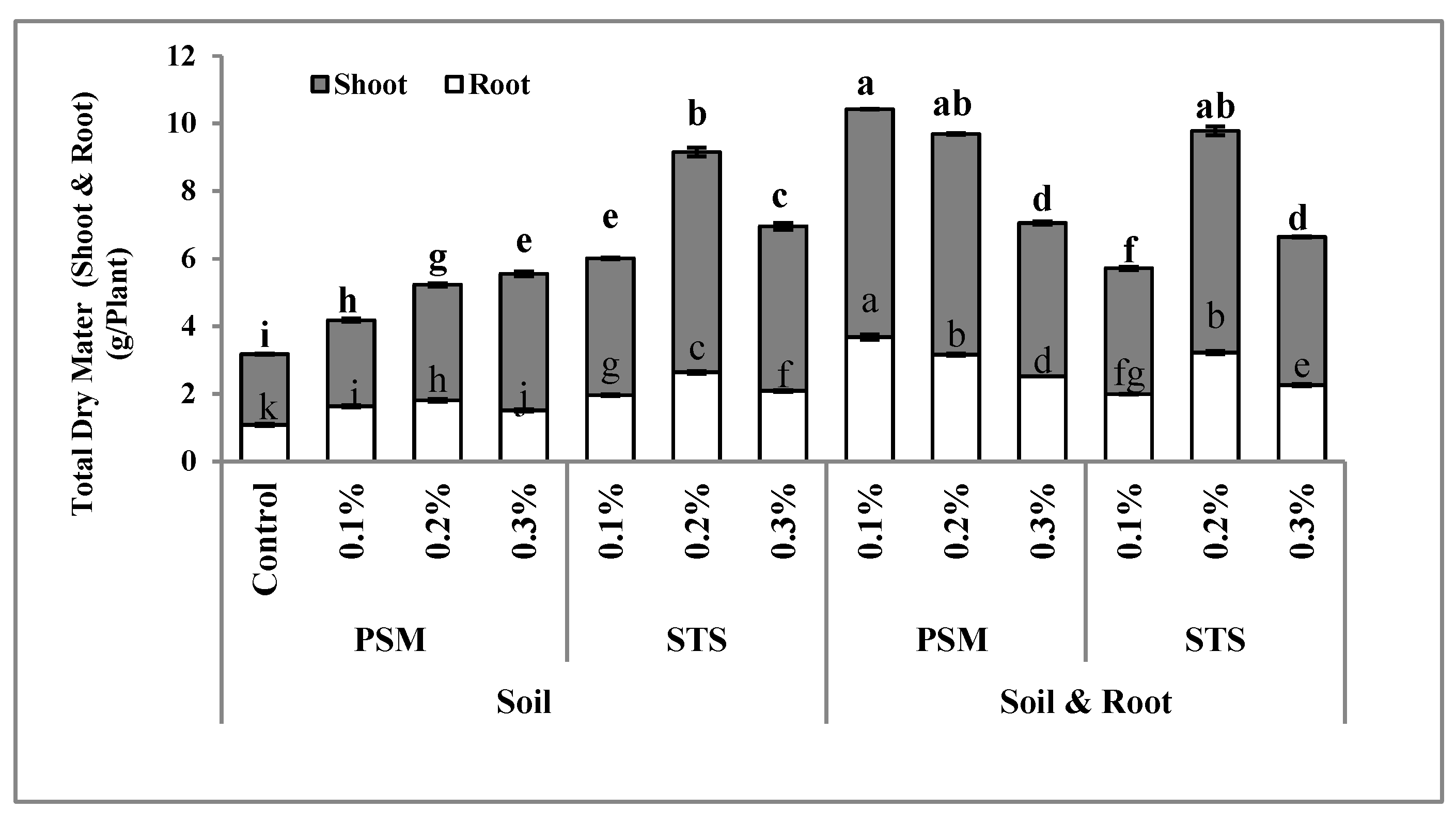
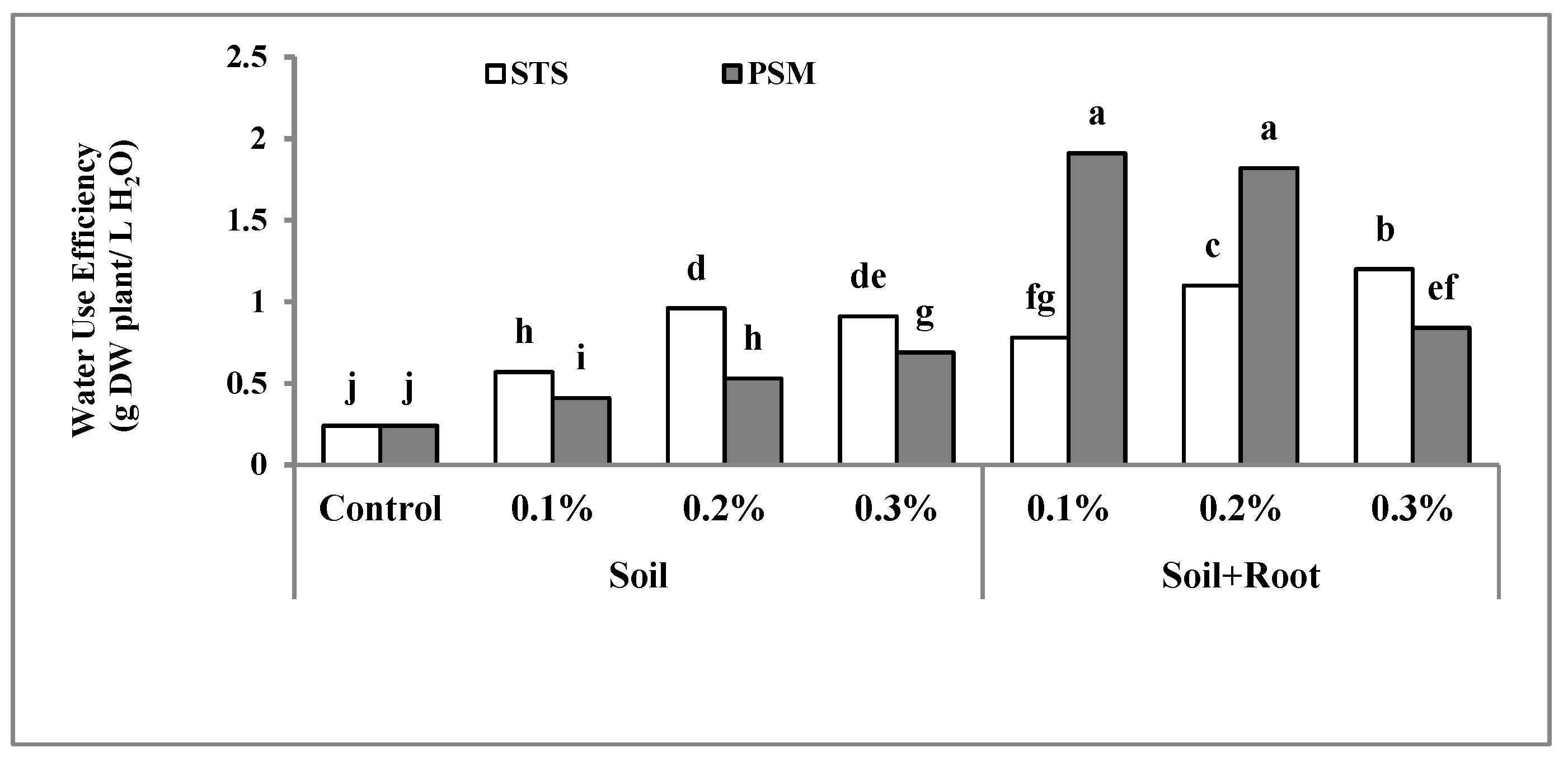
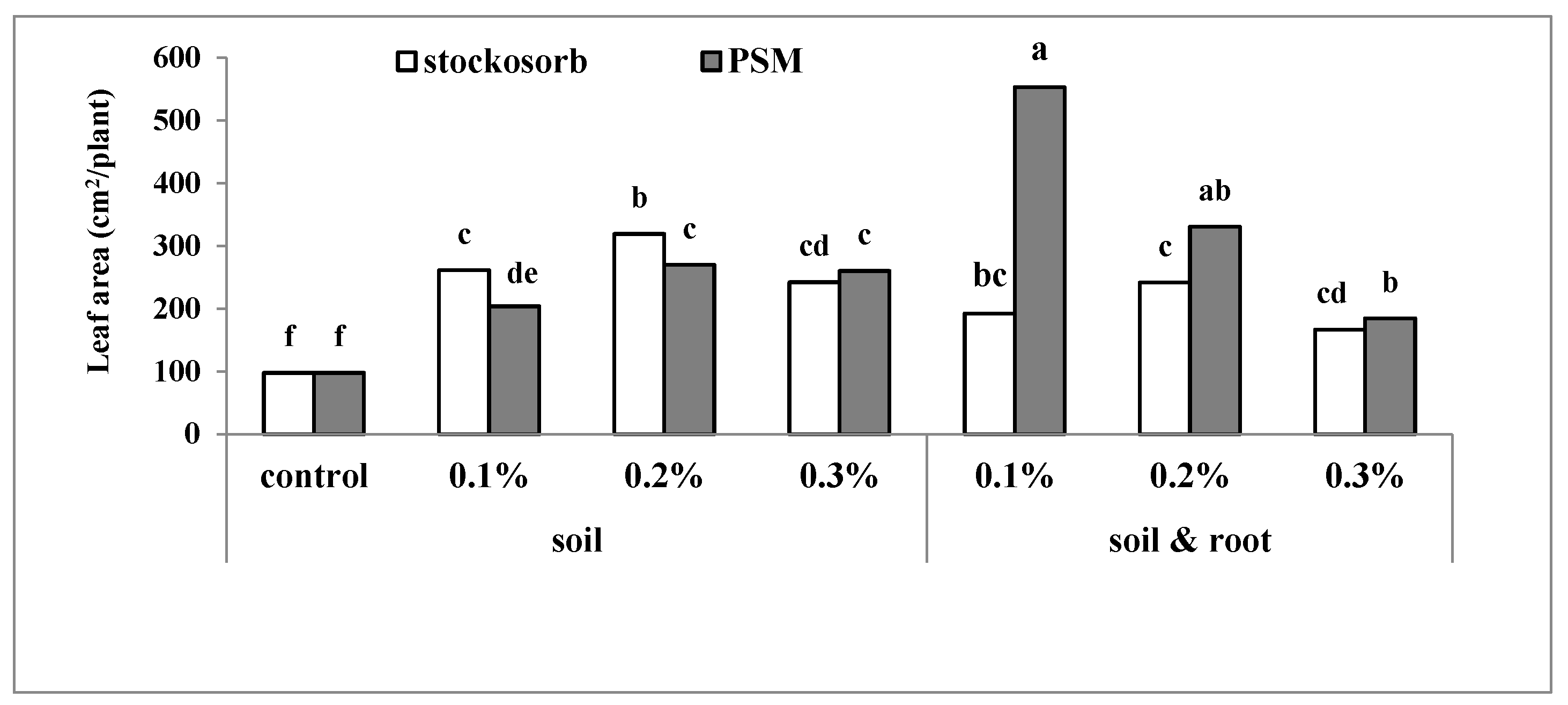
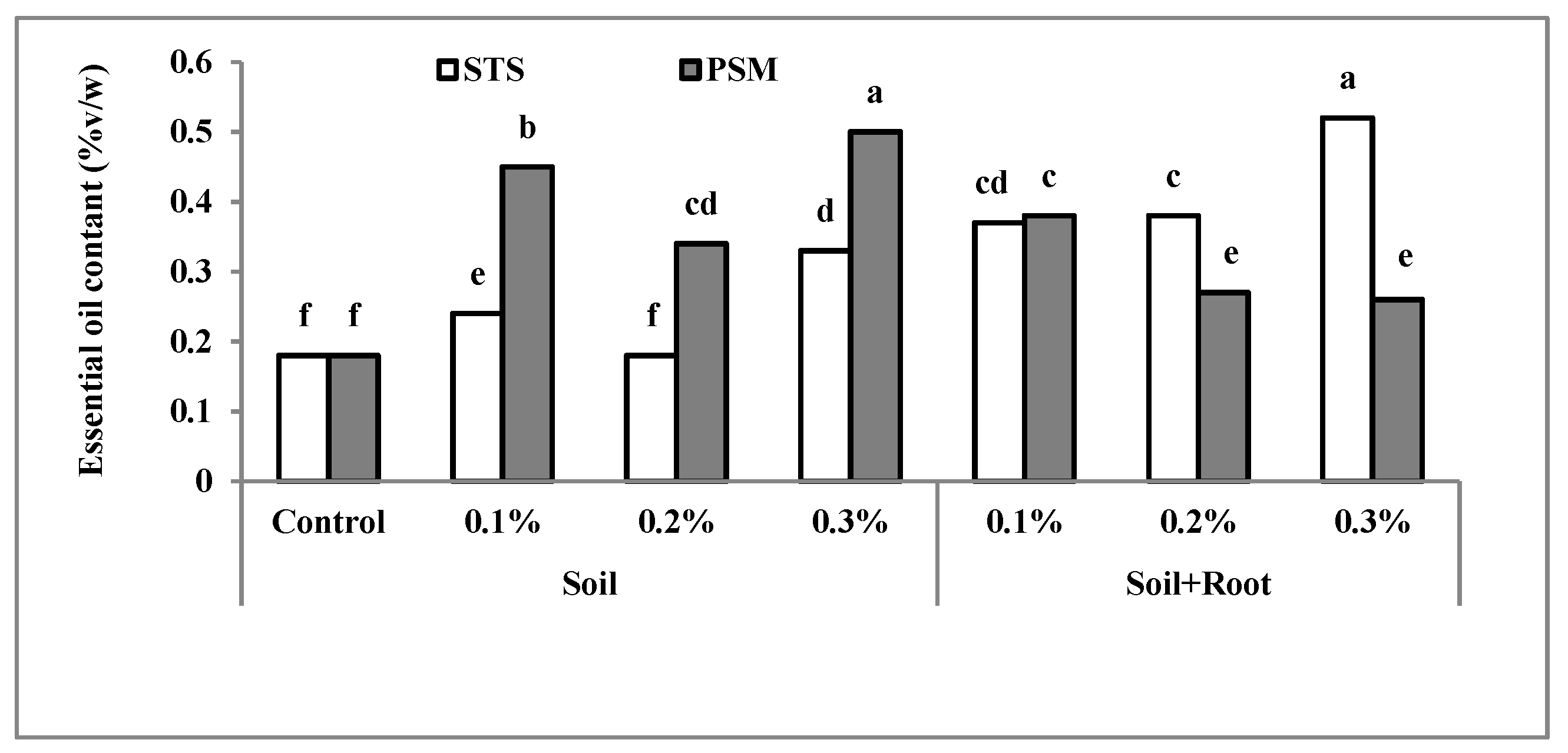
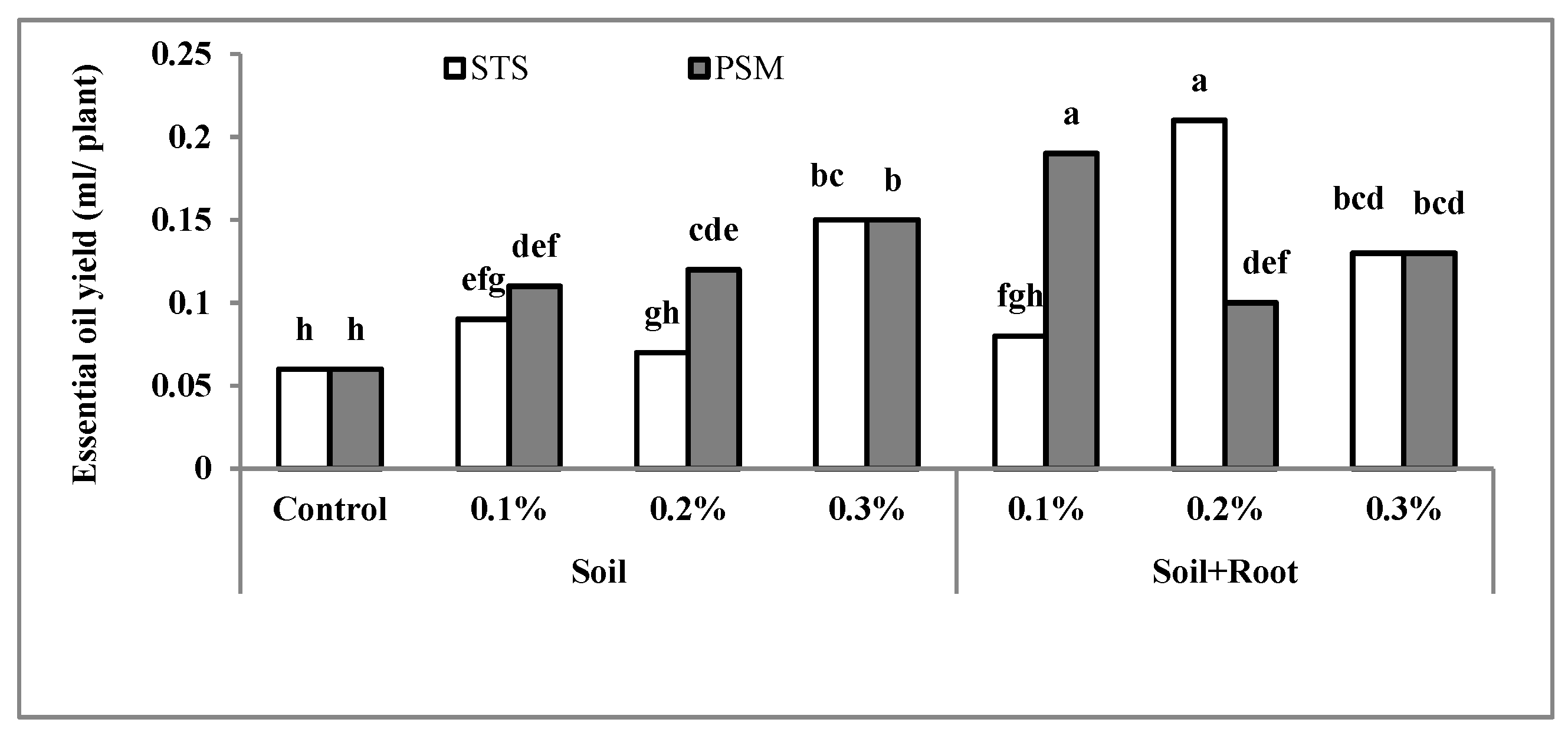
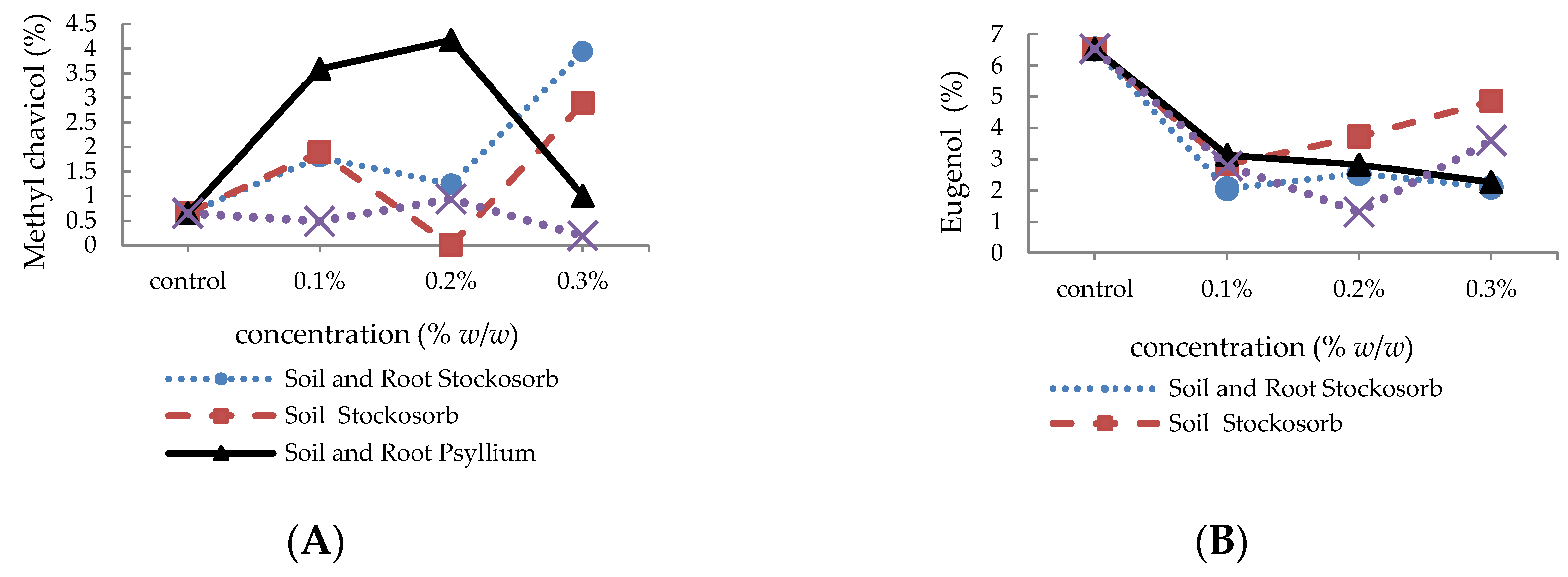
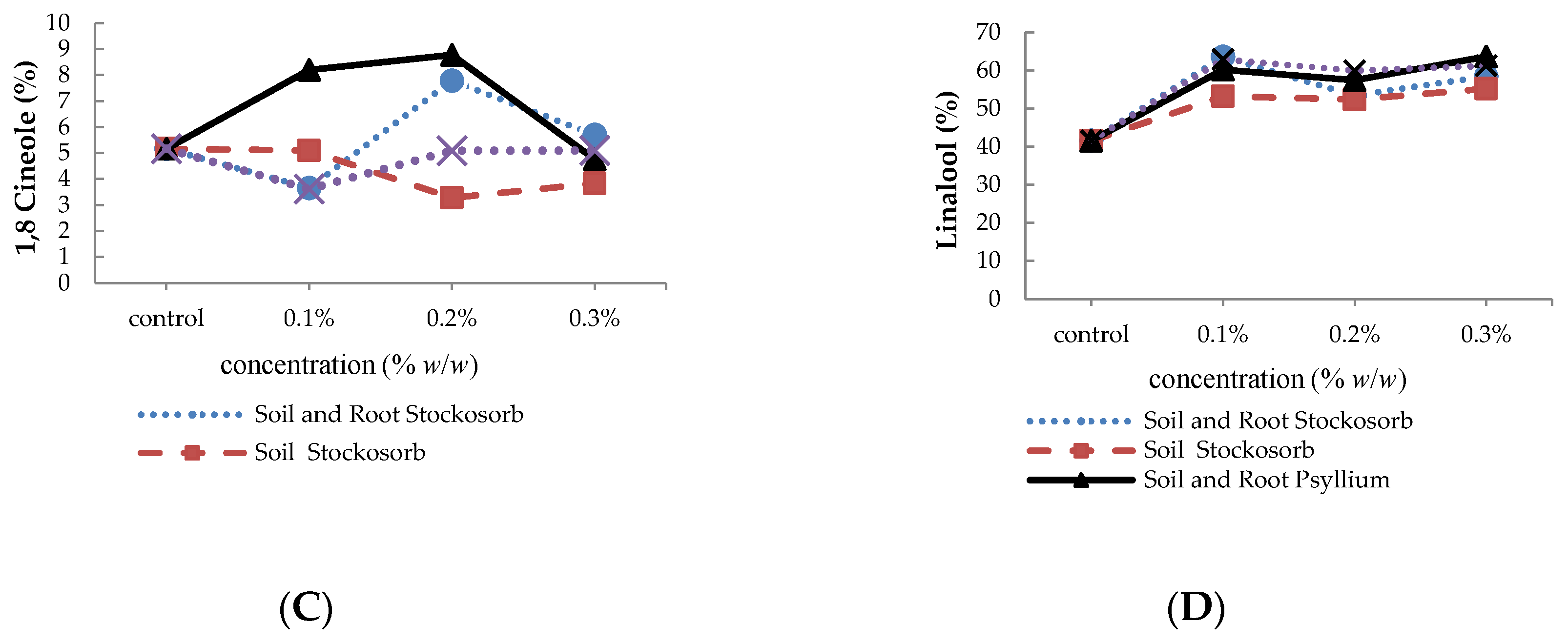
| No. | Essential Oil Components | RI * | Control | Stockosorb® | PSM | ||||
|---|---|---|---|---|---|---|---|---|---|
| 0.1% | 0.2% | 0.3% | 0.1% | 0.2% | 0.3% | ||||
| 1 | α-Thujene | 929 | - | - | 0.01 | - | - | - | - |
| 2 | α-Pinene | 933 | 0.21 | 0.10 | 0.41 | 0.21 | 0.16 | 0.40 | 0.07 |
| 3 | Camphene | 948 | 0.07 | 0.05 | 0.12 | 0.07 | 0.03 | 0.09 | - |
| 4 | Sabinene | 972 | 0.27 | 0.12 | 0.41 | 0.25 | 0.25 | 0.43 | 0.09 |
| 5 | β-Pinene | 977 | 0.65 | 0.36 | 0.95 | 0.61 | 0.63 | 1.03 | 0.29 |
| 6 | Myrcene | 988 | 1.22 | 0.95 | 1.23 | 0.90 | 0.80 | 1.42 | 0.43 |
| 7 | α-Terpinene | 1016 | 0.04 | - | 0.05 | 0.02 | 0.04 | - | - |
| 8 | p-Cymene | 1023 | 0.07 | 0.03 | 0.07 | 0.05 | - | - | - |
| 9 | Limonene | 1027 | 0.44 | 0.25 | 0.45 | 0.32 | 0.31 | 0.45 | 0.19 |
| 10 | 1,8-Cineole | 1032 | 5.16 | 3.65 | 7.78 | 5.70 | 8.19 | 8.77 | 4.76 |
| 11 | (E)-β-Ocimene | 1044 | 0.81 | 0.62 | 0.73 | 0.56 | 0.54 | 0.88 | 0.48 |
| 12 | δ-Terpinene | 1056 | 0.08 | 0.03 | 0.08 | 0.03 | 0.07 | 0.07 | - |
| 13 | trans-Linalool oxide | 1078 | - | 0.25 | - | 0.17 | 0.20 | 0.13 | - |
| 14 | Terpinolene | 1087 | 0.08 | 0.04 | 0.11 | 0.06 | 0.06 | 0.07 | - |
| 15 | Linalool | 1104 | 41.55 | 63.54 | 53.39 | 58.44 | 60.18 | 57.41 | 63.62 |
| 16 | 1-Octen-3-yl acetate | 1110 | 0.15 | 0.12 | 0.12 | 0.14 | 0.11 | 0.10 | 0.11 |
| 17 | 3-Octanol acetate | 1128 | - | - | 0.02 | - | - | - | - |
| 18 | (E)-Myroxide | 1140 | 0.17 | 0.26 | 0.33 | 0.29 | 0.22 | 0.26 | 0.19 |
| 19 | Camphor | 1146 | 0.72 | 0.85 | 1.06 | 0.62 | 0.61 | 0.73 | 0.51 |
| 20 | Borneol | 1167 | 0.20 | 0.17 | 0.26 | 0.33 | 0.32 | 0.23 | 0.19 |
| 21 | Terpinene-4-ol | 1177 | 0.40 | 0.15 | 0.37 | 0.15 | 0.39 | 0.21 | 0.21 |
| 22 | α-Terpineol | 1191 | 0.98 | 0.69 | 0.97 | 0.84 | 1.23 | 0.94 | 0.94 |
| 23 | Methyl chavicol | 1197 | 0.65 | 1.79 | 1.24 | 3.94 | 3.59 | 4.17 | 1.00 |
| 24 | Octanol acetate | 1209 | 0.64 | 0.42 | 0.53 | 0.36 | 0.48 | 0.29 | 0.31 |
| 25 | Nerol | 1230 | - | 0.07 | - | 0.04 | - | - | - |
| 26 | Geraniol | 1253 | 0.88 | 0.87 | 0.34 | 0.59 | 0.36 | 0.30 | 1.32 |
| 27 | Bornyl acetate | 1285 | 2.10 | 1.40 | 1.45 | 1.36 | 1.14 | 1.01 | 0.68 |
| 28 | Myrtenyl acetate | 1324 | 0.12 | 0.04 | 0.05 | 0.06 | 0.10 | - | - |
| 29 | δ-Elemene | 1341 | 0.11 | 0.06 | 0.11 | 0.07 | 0.16 | - | - |
| 30 | α-Cubebene | 1350 | - | 0.06 | 0.08 | 0.05 | - | - | - |
| 31 | Eugenol | 1359 | 6.53 | 2.05 | 2.53 | 2.10 | 3.13 | 2.82 | 2.26 |
| 32 | Neryl acetate | 1365 | - | - | - | - | - | - | - |
| 33 | α-Copaene | 1374 | 0.19 | 0.14 | 0.16 | 0.12 | 0.11 | 0.11 | 0.16 |
| 34 | Geranyl acetate | 1381 | 1.21 | 0.48 | 0.37 | 0.32 | 0.29 | 0.29 | 0.69 |
| 35 | β-Elemene | 1390 | 3.76 | 1.96 | 2.27 | 1.97 | 1.77 | 2.04 | 2.36 |
| 36 | Methyl eugenol | 1403 | 0.08 | 0.11 | 0.17 | 0.10 | 0.10 | 0.13 | - |
| 37 | (E)-Caryophyllene | 1418 | 0.65 | 0.30 | 0.56 | 0.40 | 0.35 | 0.23 | 0.43 |
| 38 | trans-α-Bergamotene | 1434 | 5.36 | 3.10 | 3.03 | 2.65 | 1.86 | 2.64 | 2.71 |
| 39 | α-Guaiene | 1437 | 0.92 | 0.44 | 0.49 | 0.40 | 0.36 | 0.45 | 0.52 |
| 40 | α-Humulene | 1453 | 1.51 | 0.55 | 0.72 | 0.61 | 0.56 | 0.58 | 0.77 |
| 41 | allo-Aromadendrene | 1461 | 0.39 | 0.21 | 0.31 | 0.26 | 0.19 | 0.21 | 0.29 |
| 42 | Germacrene D | 1480 | 3.26 | 1.84 | 2.30 | 1.76 | 1.58 | 1.79 | 2.81 |
| 43 | β-Selinene | 1489 | - | - | 0.10 | 0.13 | - | - | - |
| 44 | Bicyclogermacrene | 1495 | 0.88 | 0.48 | 0.51 | 0.47 | 0.44 | 0.44 | 0.62 |
| 45 | α-Bulnesene | 1504 | 1.97 | 1.09 | 1.18 | 0.95 | 0.83 | 1.01 | 1.17 |
| 46 | δ-Cadinene | 1513 | 2.84 | 1.69 | 1.99 | 1.77 | 1.31 | 1.49 | 1.96 |
| 47 | trans-Calamenene | 1521 | 0.65 | 0.35 | 0.38 | 0.39 | 0.27 | 0.32 | 0.41 |
| 48 | (E)-Nerolidol | 1561 | 0.26 | 0.13 | 0.19 | 0.14 | 0.10 | - | - |
| 49 | Spathulenol | 1577 | 0.82 | 0.64 | 0.70 | 0.58 | 0.37 | 0.39 | 0.43 |
| 50 | Caryophyllene oxide | 1583 | 0.28 | 0.17 | 0.28 | 0.23 | 0.15 | - | - |
| 51 | 1,10-di-epi-Cubenol | 1614 | 1.13 | 0.82 | 0.95 | 0.84 | 0.73 | 0.55 | 0.71 |
| 52 | epi-α-Cadinol | 1642 | 7.16 | 5.06 | 5.87 | 5.47 | 4.21 | 4.20 | 5.29 |
| 53 | β-Eudesmol | 1650 | 0.26 | 0.04 | - | 0.04 | - | - | - |
| 54 | α-Cadinol | 1654 | 0.57 | 0.20 | 0.21 | 0.19 | 0.15 | - | - |
| 55 | epi-α-Bisabolol | 1687 | - | - | 0.36 | 0.22 | - | - | - |
| The number of compounds | 47 | 49 | 51 | 52 | 46 | 40 | 35 | ||
| percent of known compounds | 98.45 | 98.59 | 98.35 | 98.34 | 99.03 | 99.08 | 98.77 | ||
| No. | Essential Oil Components | RI * | Control | Stockosorb® | PSM | ||||
|---|---|---|---|---|---|---|---|---|---|
| 0.1% | 0.2% | 0.3% | 0.1% | 0.2% | 0.3% | ||||
| 1 | α-Pinene | 933 | 0.21 | 0.25 | 0.14 | 0.20 | 0.10 | 0.21 | 0.18 |
| 2 | Camphene | 948 | 0.07 | 0.07 | - | 0.08 | 0.04 | 0.09 | 0.06 |
| 3 | Sabinene | 972 | 0.27 | 0.23 | 0.12 | 0.17 | 0.12 | 0.24 | 0.20 |
| 4 | β-Pinene | 977 | 0.65 | 0.61 | 0.41 | 0.45 | 0.33 | 0.61 | 0.54 |
| 5 | Myrcene | 988 | 1.22 | 0.95 | 0.95 | 1.24 | 0.98 | 1.01 | 0.94 |
| 6 | α-Terpinene | 1016 | 0.04 | - | - | 0.03 | - | 0.02 | 0.02 |
| 7 | p-Cymene | 1023 | 0.07 | - | - | 0.04 | - | 0.03 | 0.03 |
| 8 | Limonene | 1027 | 0.44 | 0.34 | 0.25 | 0.28 | 0.22 | 0.31 | 0.28 |
| 9 | 1,8-Cineole | 1032 | 5.16 | 5.10 | 3.28 | 3.83 | 3.62 | 5.09 | 5.10 |
| 10 | (E)-β-Ocimene | 1044 | 0.81 | 0.70 | 0.82 | 1.02 | 0.89 | 0.76 | 0.47 |
| 11 | δ-Terpinene | 1056 | 0.08 | - | - | 0.05 | - | 0.04 | 0.04 |
| 12 | trans-Linalool oxide | 1078 | - | - | 0.20 | - | 0.21 | - | 0.18 |
| 13 | Terpinolene | 1087 | 0.08 | 0.04 | - | 0.10 | 0.04 | 0.10 | 0.06 |
| 14 | Linalool | 1104 | 41.55 | 53.20 | 52.38 | 55.17 | 62.82 | 59.92 | 61.16 |
| 15 | 1-Octen-3-yl acetate | 1110 | 0.15 | 0.09 | - | 0.09 | 0.09 | 0.08 | 0.09 |
| 16 | (E)-Myroxide | 1140 | 0.17 | 0.25 | 0.23 | 0.36 | 0.36 | 0.24 | 0.19 |
| 17 | Camphor | 1146 | 0.72 | 0.93 | 1.00 | 0.97 | 0.61 | 1.03 | 0.83 |
| 18 | Borneol | 1167 | 0.20 | 0.19 | - | 0.14 | 0.12 | 0.17 | 0.19 |
| 19 | Terpinene-4-ol | 1177 | 0.40 | 0.18 | 0.15 | 0.32 | 0.13 | 0.13 | 0.16 |
| 20 | α-Terpineol | 1191 | 0.98 | 0.89 | 0.64 | 0.69 | 0.57 | 0.67 | 0.74 |
| 21 | Methyl chavicol | 1197 | 0.65 | 1.89 | - | 2.89 | 0.49 | 0.94 | 0.19 |
| 22 | Octanol acetate | 1209 | 0.64 | 0.33 | 0.31 | 0.52 | - | 0.29 | 0.36 |
| 23 | Nerol | 1230 | - | - | - | 0.09 | - | 0.04 | 0.04 |
| 24 | Geraniol | 1253 | 0.88 | 1.02 | 3.07 | 1.36 | 0.22 | 0.95 | 0.97 |
| 25 | Bornyl acetate | 1285 | 2.10 | 1.13 | 0.78 | 1.14 | 1.09 | 0.77 | 0.79 |
| 26 | Myrtenyl acetate | 1324 | 0.12 | - | - | - | - | 0.06 | 0.04 |
| 27 | δ-Elemene | 1341 | 0.11 | - | - | 0.06 | - | 0.04 | 0.08 |
| 28 | α-Cubebene | 1350 | - | - | - | 0.05 | - | - | 0.07 |
| 29 | Eugenol | 1359 | 6.53 | 2.83 | 3.72 | 4.85 | 2.79 | 1.31 | 3.60 |
| 30 | α-Copaene | 1374 | 0.19 | 0.21 | - | 0.12 | 0.15 | 0.10 | 0.15 |
| 31 | Geranyl acetate | 1381 | 1.21 | 0.53 | 0.68 | 0.75 | 0.38 | 0.60 | 0.62 |
| 32 | β-Elemene | 1390 | 3.76 | 3.47 | 3.11 | 2.59 | 2.35 | 1.74 | 2.72 |
| 33 | Methyl eugenol | 1403 | 0.08 | 0.14 | 0.43 | 0.08 | 0.38 | 0.09 | 0.11 |
| 34 | (E)-Caryophyllene | 1418 | 0.65 | 0.58 | 0.59 | 0.39 | 0.32 | 0.36 | 0.29 |
| 35 | trans-a-Bergamotene | 1434 | 5.36 | 3.47 | 5.33 | 3.62 | 2.37 | 2.11 | 2.37 |
| 36 | α-Guaiene | 1437 | 0.92 | 0.81 | 0.74 | 0.59 | 0.59 | 0.35 | 0.60 |
| 37 | α-Humulene | 1453 | 1.51 | 0.96 | 1.40 | 0.71 | 0.78 | 0.47 | 0.72 |
| 38 | allo-Aromadendrene | 1461 | 0.39 | 0.37 | 0.28 | 0.25 | 0.26 | 0.16 | 0.24 |
| 39 | Germacrene D | 1480 | 3.26 | 3.06 | 2.67 | 2.04 | 2.07 | 1.50 | 2.41 |
| 40 | β-Selinene | 1489 | - | - | 0.48 | 0.15 | - | - | - |
| 41 | Bicyclogermacrene | 1495 | 0.88 | 0.93 | 1.00 | 0.62 | 0.60 | 0.46 | 0.70 |
| 42 | α-Bulnesene | 1504 | 1.97 | 1.80 | 1.66 | 1.37 | 1.37 | 0.83 | 1.37 |
| 43 | δ-Cadinene | 1513 | 2.84 | 2.44 | 2.07 | 1.73 | 2.06 | 1.25 | 1.61 |
| 44 | trans-Calamenene | 1521 | 0.65 | 0.49 | 0.49 | 0.38 | 0.37 | 0.25 | 0.33 |
| 45 | (E)-Nerolidol | 1561 | 0.26 | 0.17 | 0.22 | 0.14 | 0.16 | 0.11 | 0.19 |
| 46 | Spathulenol | 1577 | 0.82 | 0.50 | 0.89 | 0.60 | 0.87 | 0.43 | 0.64 |
| 47 | Caryophyllene oxide | 1583 | 0.28 | - | 0.28 | 0.23 | 0.22 | 0.11 | 0.17 |
| 48 | 1,10-di-epi-Cubenol | 1614 | 1.13 | 0.93 | 0.97 | 0.78 | 0.98 | 0.58 | 0.76 |
| 49 | epi-α-Cadinol | 1642 | 7.16 | 6.64 | 6.31 | 4.98 | 6.23 | 3.76 | 4.86 |
| 50 | β-Eudesmol | 1650 | 0.26 | - | - | - | - | - | 0.05 |
| 51 | α-Cadinol | 1654 | 0.57 | 0.19 | 0.64 | 0.20 | 0.26 | 0.15 | 0.17 |
| 52 | epi-α-Bisabolol | 1686 | - | - | - | 0.17 | - | - | - |
| The number compounds | 45 | 40 | 37 | 49 | 41 | 47 | 50 | ||
| percent of compounds | 98.45 | 98.91 | 98.69 | 98.68 | 98.61 | 99.02 | 98.68 |
| Texture | pH | Electrical Conductivity (Ds/ms) | OM% | OC% | P% | K % | N % |
|---|---|---|---|---|---|---|---|
| Sandy loam | 7.8 | 1.21 | 0.64 | 0.37 | 0.002 | 0.023 | 0.064 |
| Water Used (L) | |||||
|---|---|---|---|---|---|
| Control (0) | 23 | ||||
| Stockosorb® | PSM | ||||
| (Soil Application) | (Soil + Root Application) | (Soil Application) | (Soil + Root Application) | ||
| Concentration | 0.1% | 26 | 24 | 26 | 23 |
| 0.2% | 24 | 26 | 24 | 22 | |
| 0.3% | 25 | 21 | 22 | 23 | |
© 2020 by the authors. Licensee MDPI, Basel, Switzerland. This article is an open access article distributed under the terms and conditions of the Creative Commons Attribution (CC BY) license (http://creativecommons.org/licenses/by/4.0/).
Share and Cite
Beigi, S.; Azizi, M.; Iriti, M. Application of Super Absorbent Polymer and Plant Mucilage Improved Essential Oil Quantity and Quality of Ocimum basilicum var. Keshkeni Luvelou. Molecules 2020, 25, 2503. https://doi.org/10.3390/molecules25112503
Beigi S, Azizi M, Iriti M. Application of Super Absorbent Polymer and Plant Mucilage Improved Essential Oil Quantity and Quality of Ocimum basilicum var. Keshkeni Luvelou. Molecules. 2020; 25(11):2503. https://doi.org/10.3390/molecules25112503
Chicago/Turabian StyleBeigi, Somaye, Majid Azizi, and Marcello Iriti. 2020. "Application of Super Absorbent Polymer and Plant Mucilage Improved Essential Oil Quantity and Quality of Ocimum basilicum var. Keshkeni Luvelou" Molecules 25, no. 11: 2503. https://doi.org/10.3390/molecules25112503
APA StyleBeigi, S., Azizi, M., & Iriti, M. (2020). Application of Super Absorbent Polymer and Plant Mucilage Improved Essential Oil Quantity and Quality of Ocimum basilicum var. Keshkeni Luvelou. Molecules, 25(11), 2503. https://doi.org/10.3390/molecules25112503







